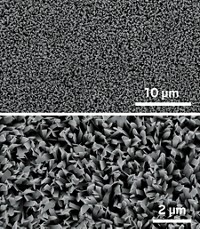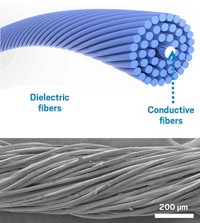Advertisement
Grab your lab coat. Let's get started
Welcome!
Welcome!
Create an account below to get 6 C&EN articles per month, receive newsletters and more - all free.
It seems this is your first time logging in online. Please enter the following information to continue.
As an ACS member you automatically get access to this site. All we need is few more details to create your reading experience.
Not you? Sign in with a different account.
Not you? Sign in with a different account.
ERROR 1
ERROR 1
ERROR 2
ERROR 2
ERROR 2
ERROR 2
ERROR 2
Password and Confirm password must match.
If you have an ACS member number, please enter it here so we can link this account to your membership. (optional)
ERROR 2
ACS values your privacy. By submitting your information, you are gaining access to C&EN and subscribing to our weekly newsletter. We use the information you provide to make your reading experience better, and we will never sell your data to third party members.
Materials
Power From Motion
Nanogenerators exploit mechanical processes inside and outside the body to power electronic devices
by David Pittman
August 2, 2010
| A version of this story appeared in
Volume 88, Issue 31

It’s a couch potato’s dream: Several research groups across the country are working on harnessing energy to power electronic devices from simple acts such as breathing or walking to the refrigerator. These scientists hope that piezoelectric nanowires and crystals—materials that produce an electric potential when bent or stressed—can convert biomechanical processes into electricity and wean people off of using batteries in some daily activities.
“I anticipate in two to five years we will have true applications that will reach industry products,” says Zhong Lin Wang, director of the Center for Nanostructure Characterization at Georgia Institute of Technology.
Although materials vary from lab to lab, researchers aim to sew these piezoelectric fibers into clothes to drive handheld music devices or to install them in the body to power sensors or pacemakers. The latter would eliminate surgeries required every few years to replace dead batteries. Environmental sensors incorporating the fibers could gather energy from their surroundings and wouldn’t need to rely on finicky solar power.
But before the public gets worked up over an iPod powered by walking or an everlasting glucose monitor, researchers such as Wang must first find ways to increase the power generated from current nanogenerators nearly 5,000-fold. A typical pacemaker requires about 5 mW of power, whereas today’s nanogenerators, some built with tens of thousands or hundreds of thousands of piezoelectric nanowires, top out at around only a microwatt of power.
Still, the energy available inside the human body far exceeds that needed to power a device, says Xudong Wang, an engineer at the University of Wisconsin, Madison, whose research deals with improving the energy-harvesting efficiency of piezoelectric devices. Nanogenerator designers just need to find a way to capture more energy, he says. The ways to do so, however, are limited.
Michael C. McAlpine of the department of mechanical and aerospace engineering at Princeton University lists three ways in which researchers can increase power: They can improve the efficiency of the generator, boost the amount of stress applied to the generator, or increase the size or number of generators.
Liwei Lin, a mechanical engineer at the University of California, Berkeley, says that achieving power goals in the milliwatt range with nanogenerators is, in fact, possible. But it will happen only if commercial industry embraces the technology, he adds.
“We are not introducing any new science,” so a lot of the work would involve engineering, Lin says. “All the basic principles are there. It’s not that difficult to assemble things,” he says.
Lin works with polyvinylidene fluoride (PVDF), a polymer with high mechanical strength that has been used in fishing lines and insulation on electrical wires. The PVDF nanofibers his group has engineered are roughly 10 times as efficient at harvesting energy as are conventional PVDF thin films (Nano Lett., DOI: 10.1021/nl9040719).
The research team’s goal is to weave the long, thin fibers into fabric for clothes. A wearer’s movements could generate power for cell phones and MP3 players. Lin hopes to take advantage of one of McAlpine’s principles and incorporate large numbers of fibers—up to 1 million in a single garment—to generate enough power for an iPod.
Lin has calculated that his fibers create about 10 mV of electrical potential. With 1 million fibers to convert movements into electrical energy and 1,000 electrodes connected in parallel to capture that energy, he estimates an article of clothing could generate about 50 mW of power. That’s enough to charge and sustain an energy-hungry smartphone. “A million looks like a lot, but relatively speaking, it’s not,” because clothes also contain millions of fibers, Lin says.
Typical clothing fibers have a diameter of about 10 μm. The diamter of the fiber Lin’s lab works with is less than 1 μm. He claims his PVDF fibers could be swapped for those in today’s clothing or added on top of them and a wearer would never know the difference.
The federal government is already eyeing the technology. Along with the National Science Foundation, the Department of Defense has funded research in the area. Specifically, DOD hopes that if body movements can be used to power electronic devices, soldiers would no longer have to lug heavy batteries with their gear.
Other scientists hope to gather power from inside the body rather than from the external movements that Lin aims to exploit. For example, the nanogenerators developed by Georgia Tech’s Wang and Princeton’s McAlpine generate electricity from tiny motions such as the beating of the heart or the lungs’ rise and fall.
Zhong Lin Wang has spent the past six years creating nanogenerators and publishing dozens of papers on his work. He grows piezoelectric zinc oxide nanowires on a gold-coated surface, which he then attaches to a platinum-coated silicon wafer. The hybrid wires, five-thousandths of an inch in diameter, can power an ultraviolet nanosensor by harvesting mechanical energy (Nat. Nanotechnol., DOI: 10.1038/nnano.2010.46).
However, Wang found that he can boost power output by coupling these piezoelectric nanowires with an enzyme-based “biofuel” cell that can collect energy from glucose-containing fluids such as blood. The device captures the electron flow from the oxidation of glucose to gluconolactone. Meanwhile, the piezoelectric nanowires feed off the flow of blood: As the heart beats and creates a fluctuating flow of blood throughout the body, the fluid compresses and relaxes the nanowires to create an alternating current (ACS Nano, DOI: 10.1021/nn100845b).
Wang believes he can further boost power by better integrating piezoelectric nanowires and enzyme-based biofuel cells into a new nanogenerator. Because a paper on the topic has only recently been submitted and is not yet published, he declined to talk with C&EN about the system’s specifics. “By optimizing the structure and design, we are confident that we will reach an output power in the milliwatt range,” he says.
Earlier this year, Wang reported harvesting energy from a rat’s beating heart and contracting diaphragm to power a piezoelectric-wire-based nanogenerator (Adv. Mater., DOI: 10.1002/adma.200904355). Even though he has yet to test the system in humans, he says that his ZnO nanowires are biodegradable.
Meanwhile, McAlpine has combined silicone and nanoribbons of lead zirconate titanate (PZT) to make an implantable piezoelectric material. PZT, ordinarily a brittle ceramic, becomes flexible and biocompatible when encapsulated in silicone. McAlpine says that the material is the most efficient piezoelectric substance known and scavenges energy nearly 10 times as well as ZnO (Nano Lett., DOI: 10.1021/nl903377u).
His team’s version of PZT “could be used to conform to your lungs or put against your rib cage for harvesting energy from breathing for implantable devices such as a pacemaker,” McAlpine says. To increase power from the piezoelectric material, McAlpine says, it can be placed in other areas such as on the bottom of shoes so the material receives more stress and generates more energy.
In the meantime, McAlpine, Wang, and their colleagues must work to ramp up the power from their tiny wires before iPod owners can hope to recharge their devices by running around the block.





Join the conversation
Contact the reporter
Submit a Letter to the Editor for publication
Engage with us on Twitter